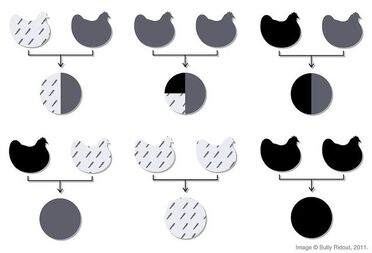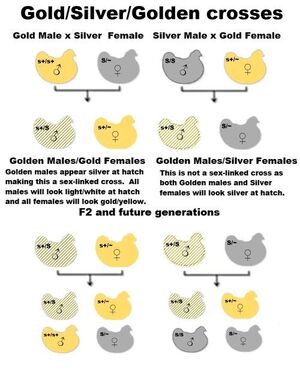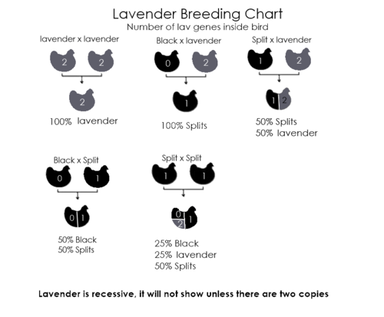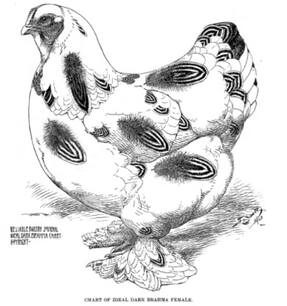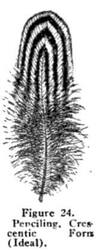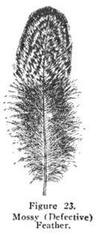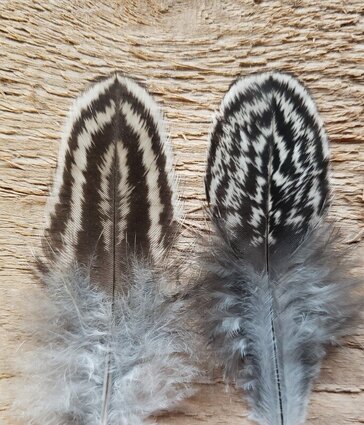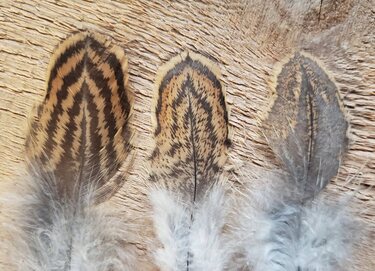Chicken color genetics are surprisingly complex. It is particularly difficult to find reliable information on various Brahma varieties because buff, light, and dark are the only accepted varieties in the US and therefore the only ones included in the Standard of Perfection. Trying to learn about nonstandard varieties (i.e. project colors) quickly gets confusing due to 1) the general complexity of color genetics, 2) the inconsistency in names for different varieties, and 3) the massive amount of misinformation shared online.
At Feather & Fern Farmstead we specialize in penciled varieties. For those of you who would like to have a deeper understanding of these varieties and the genetics behind them, I suggest reading all the content in this page in the order it is presented. If you are looking only for a description of what the different varieties are and some common issues buyers run into, you may want to skip towards the end and only read the "Penciled Varieties" section.
Please note that this is not an exhaustive guide to all color genetics topics, but only a surface level overview of the topics that are most relevant to penciled Brahma varieties.
At Feather & Fern Farmstead we specialize in penciled varieties. For those of you who would like to have a deeper understanding of these varieties and the genetics behind them, I suggest reading all the content in this page in the order it is presented. If you are looking only for a description of what the different varieties are and some common issues buyers run into, you may want to skip towards the end and only read the "Penciled Varieties" section.
Please note that this is not an exhaustive guide to all color genetics topics, but only a surface level overview of the topics that are most relevant to penciled Brahma varieties.
Basic Color Genetics
Andalusian Blue
Have you ever seen chickens or eggs described as "BBS" and wondered what on earth that means? BBS stands for blue, black, splash. This is in reference to a gene called Andalusian Blue.
Every chicken has zero, one, or two copies of the Andalusian Blue gene. Having no copies of this gene leaves a chicken black. One copy of the gene dilutes this black to blue. Blue can range from a light-ish gray to a very dark gray; sometimes it's an even color throughout the body, sometimes there's a fleck or two of black, and sometimes some areas like the head and hackles are darker than the rest of the body. Two copies of this same gene dilutes the black even further to what is called splash. Splash is a lighter gray with flecks of darker gray and/or black. Whether this black, blue, or splash is the ENTIRE chicken (i.e. they're solid black, blue, or splash) or is just the pattern color is controlled by a number of different genes, but the way this blue gene works and how it is inherited applies to all chickens of any pattern.
Black is more or less treated as the "default" and when a bird is black patterned, the black aspect is typically not specified in the name. For example buff, light, and partridge all refer to black patterned birds. When there is one copy of the Andalusian Blue gene turning this pattern blue, blue gets added in front of the name (blue buff, blue light, blue partridge, etc.). When there are two copies turning the pattern splash, splash gets added in front of the name (splash buff, splash light, splash partridge, etc.). You will sometimes see people include both blue and splash in the name (for example, "blue splash partridge") but this is incorrect; an individual bird can be blue OR splash but never both, and there is no reason to include the word "blue" when you are describing splash individuals.
Now, for how this gene is inherited...
As the heterozygous form of this gene, blue birds produce up to two different outcomes in the offspring (if bred to black or splash) and up to 3 different outcomes (if bred to another blue). This is why breeders usually aren't able to offer eggs that will only hatch blue patterned chicks.
Have you ever seen chickens or eggs described as "BBS" and wondered what on earth that means? BBS stands for blue, black, splash. This is in reference to a gene called Andalusian Blue.
Every chicken has zero, one, or two copies of the Andalusian Blue gene. Having no copies of this gene leaves a chicken black. One copy of the gene dilutes this black to blue. Blue can range from a light-ish gray to a very dark gray; sometimes it's an even color throughout the body, sometimes there's a fleck or two of black, and sometimes some areas like the head and hackles are darker than the rest of the body. Two copies of this same gene dilutes the black even further to what is called splash. Splash is a lighter gray with flecks of darker gray and/or black. Whether this black, blue, or splash is the ENTIRE chicken (i.e. they're solid black, blue, or splash) or is just the pattern color is controlled by a number of different genes, but the way this blue gene works and how it is inherited applies to all chickens of any pattern.
Black is more or less treated as the "default" and when a bird is black patterned, the black aspect is typically not specified in the name. For example buff, light, and partridge all refer to black patterned birds. When there is one copy of the Andalusian Blue gene turning this pattern blue, blue gets added in front of the name (blue buff, blue light, blue partridge, etc.). When there are two copies turning the pattern splash, splash gets added in front of the name (splash buff, splash light, splash partridge, etc.). You will sometimes see people include both blue and splash in the name (for example, "blue splash partridge") but this is incorrect; an individual bird can be blue OR splash but never both, and there is no reason to include the word "blue" when you are describing splash individuals.
Now, for how this gene is inherited...
- Black patterned x black patterned = 100% black patterned offspring
- Black patterned x blue patterned = 50% black patterned offspring, 50% blue patterned offspring
- Black patterned x splash patterned = 100% blue patterned offspring
- Blue patterned x blue patterned = 25% black patterned offspring, 50% blue patterned offspring, 25% splash patterned offspring
- Blue patterned x splash patterned = 50% blue patterned offspring, 50% splash patterned offspring
- Splash patterned x splash patterned = 100% splash patterned offspring
As the heterozygous form of this gene, blue birds produce up to two different outcomes in the offspring (if bred to black or splash) and up to 3 different outcomes (if bred to another blue). This is why breeders usually aren't able to offer eggs that will only hatch blue patterned chicks.
Silver/Gold
In addition to having a pattern color as discussed above in the Andalusian Blue section, all chickens also have a ground color. The two core options are silver and gold--there are additional separate genes that can modify how this is expressed but that's a separate topic. Silver/gold is one of the more complicated traits because it is sex linked. Females have either one copy of the silver gene or one copy of the gold gene, and it is inherited from their father. Meanwhile, males have two copies: one inherited from their mother and one inherited from their father. Two copies of the silver gene makes a male silver, and two copies of the gold gene makes a male gold. When a male has one copy of the gold gene and one copy of the silver gene, he will look something in between. Sometimes this is a sort of straw color that is clearly neither silver nor gold, but sometimes it is such a pale yellow that it could be mistaken for silver.
The inheritance is more complicated because it is sex linked. Unlike the Andalusian Blue gene discussed above, which parent is which color is critical:
In addition to having a pattern color as discussed above in the Andalusian Blue section, all chickens also have a ground color. The two core options are silver and gold--there are additional separate genes that can modify how this is expressed but that's a separate topic. Silver/gold is one of the more complicated traits because it is sex linked. Females have either one copy of the silver gene or one copy of the gold gene, and it is inherited from their father. Meanwhile, males have two copies: one inherited from their mother and one inherited from their father. Two copies of the silver gene makes a male silver, and two copies of the gold gene makes a male gold. When a male has one copy of the gold gene and one copy of the silver gene, he will look something in between. Sometimes this is a sort of straw color that is clearly neither silver nor gold, but sometimes it is such a pale yellow that it could be mistaken for silver.
The inheritance is more complicated because it is sex linked. Unlike the Andalusian Blue gene discussed above, which parent is which color is critical:
- Gold male x gold female = 100% gold cockerels, 100% gold pullets
- Silver male x silver female = 100% silver cockerels, 100% silver pullets
- Silver male x gold female = 100% silver pullets, 100% silver/gold cockerels
- Gold male x silver female = 100% gold pullets, 100% silver/gold cockerels
- Silver/gold male x silver female = 50% gold pullets, 50% silver pullets, 50% silver/gold cockerels, 50% silver cockerels
- Silver/gold male x gold female = 50% gold pullets, 50% silver pullets, 50% silver/gold cockerels, 50% gold cockerels
Lavender
Lavender is a recessive gene that dilutes other colors, namely black and gold. It is not sex linked and it is not incompletely dominant, so its inheritance is pretty straightforward. All individuals will have 0, 1, or 2 copies of the lavender gene. Individuals with one copy will look the same as those with no copies. In biology terms these individuals with only one copy of the gene are called heterozygous, but in the poultry world they are often referred to as "splits" (they are "lavender splits" or "split to lavender"). With two copies of the lavender gene, any black will be diluted to lavender and gold will be diluted to a pale yellow. It is not recommended to combine both the lavender gene and blue gene because lavender can look very similar to both lighter blues and darker splashes, so having all those in your gene pool can make it difficult to tell what you are working with.
Lavender is a recessive gene that dilutes other colors, namely black and gold. It is not sex linked and it is not incompletely dominant, so its inheritance is pretty straightforward. All individuals will have 0, 1, or 2 copies of the lavender gene. Individuals with one copy will look the same as those with no copies. In biology terms these individuals with only one copy of the gene are called heterozygous, but in the poultry world they are often referred to as "splits" (they are "lavender splits" or "split to lavender"). With two copies of the lavender gene, any black will be diluted to lavender and gold will be diluted to a pale yellow. It is not recommended to combine both the lavender gene and blue gene because lavender can look very similar to both lighter blues and darker splashes, so having all those in your gene pool can make it difficult to tell what you are working with.
Penciled Varieties
Penciling Basics
Penciling is a pattern that involves an outline of the ground color on the outer part of the feather (see above info on silver and gold) and then alternating bands of the pattern color (see above info on black, blue, splash, and lavender) and the ground color. The transitions between the ground color and the pattern color should be crisp and defined; when there are spots of ground color breaking into the pattern color or vice versa, the penciling is described as "mossy". It should also be consistent throughout the body. It is a sexually dimorphic pattern and is only expressed in females. This makes it difficult to breed for because you are somewhat in the dark when trying to select a male that has strong penciling genetics--there are some tells, but it's not as straight forward as evaluating the penciling itself on the females. Penciling is caused by a specific combination of genes and while selective breeding is important to achieve high quality penciling, you cannot selectively breed your way to penciling if the required genes for the pattern just aren't present.
Penciling is a pattern that involves an outline of the ground color on the outer part of the feather (see above info on silver and gold) and then alternating bands of the pattern color (see above info on black, blue, splash, and lavender) and the ground color. The transitions between the ground color and the pattern color should be crisp and defined; when there are spots of ground color breaking into the pattern color or vice versa, the penciling is described as "mossy". It should also be consistent throughout the body. It is a sexually dimorphic pattern and is only expressed in females. This makes it difficult to breed for because you are somewhat in the dark when trying to select a male that has strong penciling genetics--there are some tells, but it's not as straight forward as evaluating the penciling itself on the females. Penciling is caused by a specific combination of genes and while selective breeding is important to achieve high quality penciling, you cannot selectively breed your way to penciling if the required genes for the pattern just aren't present.
Dark
Dark is one of the three accepted Brahma varieties in North America. While the word "dark" sounds pretty vague, in Brahma lingo it refers to one very specific thing: silver penciled. In other countries, this variety is often simply called "silver".
The ground color is silver and the pattern color is black. Females have penciling and the goal is for this penciling to be clear and defined, and consistent throughout the body (this is the goal with any penciled variety). The silver should be a clean, bright silver and males will always have two copies of the silver gene. Examples of darks can be seen here.
When someone is working on any of the other penciled varieties, crossing to darks is often recommended to improve type. This has led some people to think dark Brahmas have a mystical ability to improve other patterns. That is not the case. The reason they are recommended for improving other penciled varieties is because it is easier to find high quality standard varieties (as opposed to nonstandard/project colors), and dark is the only penciled standard variety. A poor quality dark will do you no more favors than a poor quality bird of another penciled variety, but the highest quality darks you can find will be better quality than the best nonstandard penciled variety you can find in the US.
Blue Dark
There are very few people working on this variety and Feather & Fern Farmstead has one of the oldest blue dark projects in the country. A true "blue dark" would simply be a blue version of dark. Same clear and defined penciling throughout the body, same clean and bright silver, with the only difference being that the black of dark Brahmas is replaced with blue. Starting this project requires crossing darks with something that carries the Andalusian blue gene (see Andalusian Blue section above for more information on this gene). The only blue or splash penciled options in Brahmas also involve reddish-brown, and the only blue options that don’t have that reddish-brown are an entirely different pattern (no penciling). So one approach lets you keep the correct pattern but introduces a lot of red/brown/orange leakage that is very difficult to breed out. The other approach may not introduce this leakage, but it will wreck the pattern and you are going to spend generations trying to recreate the penciling. And by our observations in our own blue dark line (and even our partridge line), the blue patterned birds tend to have a lot more red/brow/orange than their black patterned siblings AND the blue patterned hens tend to have messier penciling than their black patterned siblings. So whichever approach you take, getting a clean silver and crisp blue penciling is going to be an uphill battle. But that is what a true blue dark would be: identical to dark with crisp penciling on a clean silver base, but with the penciling being blue instead of black.
It takes many years to reliably get something even starting to resemble this goal. Unfortunately there has been an increasing trend of people referring to BSO hens as blue dark, so buyers should beware of this. See this post on our Facebook page for a more in depth comparison and pictures showing the differences, and scroll down on this page for additional information on BSO.
Partridge
In Brahmas, partridge refers to gold penciled. Internationally this variety is often simply called "gold" in the same way that silver penciled (which we call "dark" in the US) is called "silver" in these countries. In the US you may see it called partridge, gold partridge, and occasionally gold. In other breeds partridge involves a richer red color instead of gold. Some people are striving towards this richer red in partridge Brahmas but most seem to be pursuing the lighter gold base that is seen abroad where gold penciled Brahmas are an accepted variety. Our partridge line at Feather & Fern Farmstead is this lighter gold and it provides for a greater contrast to the penciling than the richer red base of partridges in other breeds in the US.
When one copy of the blue gene discussed above is added to partridge, it makes blue partridge. Two copies of the blue gene makes splash partridge. Occasionally people refer to splash partridges as "blue splash partridge" but this is misleading; an individual can be blue or splash but never both. Simply calling splash partridges "splash partridge" instead of "blue splash partridge" saves some unnecessary confusion. Splash partridge is also sometimes referred to as red pyle. Pyle is an entirely different pattern and, to our knowledge, there is only one person in the US working on a true pyle Brahma. But there are a handful of people selling splash partridges as "red pyles" and hiking up the price due to their supposed rarity. Buyers should beware of this tactic and remember that if you are unable to find "red pyles" or splash partridges, you can also get blue partridges and use them to breed splash partridges yourself.
Regardless of if a hen is partridge, blue partridge, or splash partridge, the penciling should be crisp and defined and should be consistently present throughout the body (breast, shoulders, back, cushion, etc.). This is something that is in great need of improvement in the US. Blue partridges often have very messy penciling, sometimes losing it entirely the farther back you go on the body. Splash partridges often don't have any to speak of.
As partridges have gotten more common, there has been an increase in people selling "partridges" that not only don't have good quality penciling, but do not even have the necessary pattern related genes for penciling and therefore should not even be considered partridge of any type. Since penciling only expresses in the females, it can be particularly difficult to identify these non-penciled "partridge" males. We have also been seeing more and more "blue partridge" males that appear to be otherwise solid blues with substantial gold leakage, and these would quickly turn a partridge line into an absolute mess. So be wary of any "partridge" stock that has inconsistent or missing penciling or if the pattern seems a bit off, even on males.
There have also been a handful of people calling their Brahmas "dark partridge". There is no such thing. Dark in the Brahma realm isn't just an adjective, it very specifically refers to the silver penciled variety. Partridge refers to gold penciled. Combining the two would get you DSO (see the next section for more info). There is no such thing as "dark partridge". Most of the Brahmas people are calling "dark partridge" look like they may have the melanotic gene. While this makes them darker in a descriptive sense, it has nothing to do with "dark" Brahmas or even "partridge" Brahmas so calling them "dark partridge" is misleading.
BSO
BSO stands for Blue Silver Orange or Blue Shoulder(ed) Orange, depending on who you ask. It is an accepted variety in Europe and has been gaining popularity in the US as a project color. Some people will say "BOS" but this is incorrect; in places where there is an official written standard for this color it is BSO, not BOS.
BSO is typically created by crossing dark with either blue partridge or splash partridge. It involves a silver base like darks, blue pattern like blue partridge, and also a combo of orange/red/brown/gold that is brought in from the blue partridge or splash partridge. This leaves the males with colorful shoulders and the females often have an overall rusty tint rather than being a clean silver like darks. First generation BSO males will also have one copy of the gold gene, usually making their hackle and saddle feathers a pale yellow. This means they do not "breed true" and will produce both gold and silver based offspring (see silver/gold section above).
Wherever there is blue, there will also be black and/or splash (as described above in the Andalusian Blue section). When the blue pattern in BSO is replaced with splash, it is called SSO or Splash Silver Orange. When it is replaced with black it is called DSO or Dark Silver Orange.
As BSO has increased in popularity, it has begun having the same quality issues as partridge where people are (knowingly or not) selling "BSO" Brahmas that do not actually have the required pattern related genes for penciling. Like all other penciled varieties, the hens should have clear and defined penciling throughout the body. The penciling on SSO hens may be difficult to see since there isn't much contrast between the splash penciling and silver base.
There has also been an increase in people referring to BSO hens as blue darks and DSO hens as darks. Since both BSOs and DSOs include this orange/red/brown/gold, unknowingly including a BSO or DSO hen in a blue dark or dark breeding pen could have disastrous outcomes, ruining the clean and bright silver that is so difficult to obtain. See this post on our Facebook page for a more in depth comparison and pictures showing the differences.
Isabel
Isabel, sometimes also called isabella, refers to different lavender varieties in different breeds. In Brahmas it revers to gold penciled (aka partridge) with the addition of two copies of the lavender gene. This results in lavender penciling on a pale gold base. Similar to SSO, the difference between the lavender and pale gold can be so subtle that it can make the penciling a bit difficult to see in pictures. But like any other penciled variety, isabel Brahma hens should have defined and consistent penciling throughout the body. As isabel Brahmas have become more popular in the US there seems to be more and more solid lavender Brahmas (sometimes with gold leakage but not penciling) being sold as isabels. It can be particularly difficult to identify the males who fall in this category since the males don't express penciling. Anyone interested in isabels should beware of this and be sure you buy from stock where all females have penciling throughout the body.
Dark is one of the three accepted Brahma varieties in North America. While the word "dark" sounds pretty vague, in Brahma lingo it refers to one very specific thing: silver penciled. In other countries, this variety is often simply called "silver".
The ground color is silver and the pattern color is black. Females have penciling and the goal is for this penciling to be clear and defined, and consistent throughout the body (this is the goal with any penciled variety). The silver should be a clean, bright silver and males will always have two copies of the silver gene. Examples of darks can be seen here.
When someone is working on any of the other penciled varieties, crossing to darks is often recommended to improve type. This has led some people to think dark Brahmas have a mystical ability to improve other patterns. That is not the case. The reason they are recommended for improving other penciled varieties is because it is easier to find high quality standard varieties (as opposed to nonstandard/project colors), and dark is the only penciled standard variety. A poor quality dark will do you no more favors than a poor quality bird of another penciled variety, but the highest quality darks you can find will be better quality than the best nonstandard penciled variety you can find in the US.
Blue Dark
There are very few people working on this variety and Feather & Fern Farmstead has one of the oldest blue dark projects in the country. A true "blue dark" would simply be a blue version of dark. Same clear and defined penciling throughout the body, same clean and bright silver, with the only difference being that the black of dark Brahmas is replaced with blue. Starting this project requires crossing darks with something that carries the Andalusian blue gene (see Andalusian Blue section above for more information on this gene). The only blue or splash penciled options in Brahmas also involve reddish-brown, and the only blue options that don’t have that reddish-brown are an entirely different pattern (no penciling). So one approach lets you keep the correct pattern but introduces a lot of red/brown/orange leakage that is very difficult to breed out. The other approach may not introduce this leakage, but it will wreck the pattern and you are going to spend generations trying to recreate the penciling. And by our observations in our own blue dark line (and even our partridge line), the blue patterned birds tend to have a lot more red/brow/orange than their black patterned siblings AND the blue patterned hens tend to have messier penciling than their black patterned siblings. So whichever approach you take, getting a clean silver and crisp blue penciling is going to be an uphill battle. But that is what a true blue dark would be: identical to dark with crisp penciling on a clean silver base, but with the penciling being blue instead of black.
It takes many years to reliably get something even starting to resemble this goal. Unfortunately there has been an increasing trend of people referring to BSO hens as blue dark, so buyers should beware of this. See this post on our Facebook page for a more in depth comparison and pictures showing the differences, and scroll down on this page for additional information on BSO.
Partridge
In Brahmas, partridge refers to gold penciled. Internationally this variety is often simply called "gold" in the same way that silver penciled (which we call "dark" in the US) is called "silver" in these countries. In the US you may see it called partridge, gold partridge, and occasionally gold. In other breeds partridge involves a richer red color instead of gold. Some people are striving towards this richer red in partridge Brahmas but most seem to be pursuing the lighter gold base that is seen abroad where gold penciled Brahmas are an accepted variety. Our partridge line at Feather & Fern Farmstead is this lighter gold and it provides for a greater contrast to the penciling than the richer red base of partridges in other breeds in the US.
When one copy of the blue gene discussed above is added to partridge, it makes blue partridge. Two copies of the blue gene makes splash partridge. Occasionally people refer to splash partridges as "blue splash partridge" but this is misleading; an individual can be blue or splash but never both. Simply calling splash partridges "splash partridge" instead of "blue splash partridge" saves some unnecessary confusion. Splash partridge is also sometimes referred to as red pyle. Pyle is an entirely different pattern and, to our knowledge, there is only one person in the US working on a true pyle Brahma. But there are a handful of people selling splash partridges as "red pyles" and hiking up the price due to their supposed rarity. Buyers should beware of this tactic and remember that if you are unable to find "red pyles" or splash partridges, you can also get blue partridges and use them to breed splash partridges yourself.
Regardless of if a hen is partridge, blue partridge, or splash partridge, the penciling should be crisp and defined and should be consistently present throughout the body (breast, shoulders, back, cushion, etc.). This is something that is in great need of improvement in the US. Blue partridges often have very messy penciling, sometimes losing it entirely the farther back you go on the body. Splash partridges often don't have any to speak of.
As partridges have gotten more common, there has been an increase in people selling "partridges" that not only don't have good quality penciling, but do not even have the necessary pattern related genes for penciling and therefore should not even be considered partridge of any type. Since penciling only expresses in the females, it can be particularly difficult to identify these non-penciled "partridge" males. We have also been seeing more and more "blue partridge" males that appear to be otherwise solid blues with substantial gold leakage, and these would quickly turn a partridge line into an absolute mess. So be wary of any "partridge" stock that has inconsistent or missing penciling or if the pattern seems a bit off, even on males.
There have also been a handful of people calling their Brahmas "dark partridge". There is no such thing. Dark in the Brahma realm isn't just an adjective, it very specifically refers to the silver penciled variety. Partridge refers to gold penciled. Combining the two would get you DSO (see the next section for more info). There is no such thing as "dark partridge". Most of the Brahmas people are calling "dark partridge" look like they may have the melanotic gene. While this makes them darker in a descriptive sense, it has nothing to do with "dark" Brahmas or even "partridge" Brahmas so calling them "dark partridge" is misleading.
BSO
BSO stands for Blue Silver Orange or Blue Shoulder(ed) Orange, depending on who you ask. It is an accepted variety in Europe and has been gaining popularity in the US as a project color. Some people will say "BOS" but this is incorrect; in places where there is an official written standard for this color it is BSO, not BOS.
BSO is typically created by crossing dark with either blue partridge or splash partridge. It involves a silver base like darks, blue pattern like blue partridge, and also a combo of orange/red/brown/gold that is brought in from the blue partridge or splash partridge. This leaves the males with colorful shoulders and the females often have an overall rusty tint rather than being a clean silver like darks. First generation BSO males will also have one copy of the gold gene, usually making their hackle and saddle feathers a pale yellow. This means they do not "breed true" and will produce both gold and silver based offspring (see silver/gold section above).
Wherever there is blue, there will also be black and/or splash (as described above in the Andalusian Blue section). When the blue pattern in BSO is replaced with splash, it is called SSO or Splash Silver Orange. When it is replaced with black it is called DSO or Dark Silver Orange.
As BSO has increased in popularity, it has begun having the same quality issues as partridge where people are (knowingly or not) selling "BSO" Brahmas that do not actually have the required pattern related genes for penciling. Like all other penciled varieties, the hens should have clear and defined penciling throughout the body. The penciling on SSO hens may be difficult to see since there isn't much contrast between the splash penciling and silver base.
There has also been an increase in people referring to BSO hens as blue darks and DSO hens as darks. Since both BSOs and DSOs include this orange/red/brown/gold, unknowingly including a BSO or DSO hen in a blue dark or dark breeding pen could have disastrous outcomes, ruining the clean and bright silver that is so difficult to obtain. See this post on our Facebook page for a more in depth comparison and pictures showing the differences.
Isabel
Isabel, sometimes also called isabella, refers to different lavender varieties in different breeds. In Brahmas it revers to gold penciled (aka partridge) with the addition of two copies of the lavender gene. This results in lavender penciling on a pale gold base. Similar to SSO, the difference between the lavender and pale gold can be so subtle that it can make the penciling a bit difficult to see in pictures. But like any other penciled variety, isabel Brahma hens should have defined and consistent penciling throughout the body. As isabel Brahmas have become more popular in the US there seems to be more and more solid lavender Brahmas (sometimes with gold leakage but not penciling) being sold as isabels. It can be particularly difficult to identify the males who fall in this category since the males don't express penciling. Anyone interested in isabels should beware of this and be sure you buy from stock where all females have penciling throughout the body.

